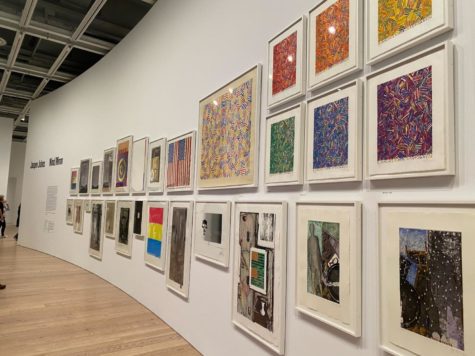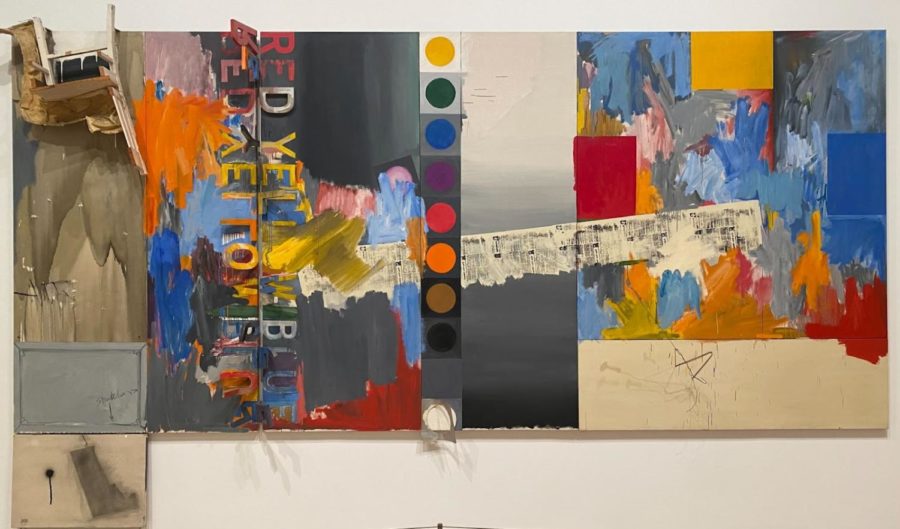Jasper Johns’s ‘Mind/Mirror’ Exhibit Tells a Star-Spangled Story
In a time of worldwide political tumult, Jasper Johns perfectly captures its essence — in paint and hot wax.
Today’s tempestuous waters of social and political malaise are turbulent. Their raging waves of bureaucratic and cultural motifs crash against the human mind. Jasper Johns’s ‘Mind/Mirror’ exhibit at the Whitney simplifies such concepts, building a bridge between modern and contemporary art over these troubled waters.
The resilient foundation of Johns’ bridge is constructed from the limp fabric of the American flag. The project came to him in a dream one night in 1954, where upon awakening, Johns was determined to translate the idea into reality. Arranging oil paint onto a bedsheet was a tedious task that endured for months, but the fruits of Johns’s labor — entitled Flag — made history.
In a 1950s era of pop art and color blocks, Flag was the odd one out. It is not quite an image of unwavering patriotism — there is a potent element of flatness to the piece. Unlike a traditional symbol of American principles, the flag does not billow in the wind. Rather, Johns deliberately morphs “things the mind already knows” into what it does not, such as an inert flag.
This impression is repeated on a myriad of occasions within the Whitney’s ‘Mind/Mirror’ exhibit. One such collection, rather creatively entitled ‘Small,’ is far from a misnomer. Within it are miniature flags, each a few inches in length. In order to preserve the details in such minute artworks, Johns created many of them using the children’s toy, Shrinky Dinks. Beyond their size, the works are akin in that they are each slight variations of the same powerful image: ‘Flag (1954-55)’.
The recurring nature of Johns’ pieces leaves much to the imagination, begging the question of what, if anything, the repetition conveys. “I found it intriguing that I can make my own conclusions about the repetitive works, not just the works themselves, but specific images within them,” remarked one museum-goer whom I interviewed.
Among these images are numbers and maps. Johns removes them from their conventional classroom context and gives them lives of their own. The artist aims to inspire the viewer with another way to see reality, taking everyday objects and placing them in anomalous settings. ‘Numbers (2017),’ for one, forms an array of digits zero through nine in neat, aluminum rows. There are no mathematical signs, but their absence multiplies the piece’s effect.
Similarly to his numerical experiments, Johns strays from “ordinary” artistic archetypes by incorporating words into his pieces. Namely, ‘Untitled (2018)’ reads, “Farley breaks down after Larry Burrows.” ‘Fool’s House—Black State (1972)’ labels the objects within it; “broom,” “cup,” and “stretcher” are inscribed in a graceful, charcoal cursive.
Independently, the mind already knows these words. When coupled with abstract images, however, they are rendered unrecognizable. To Johns, a picture is worth a thousand words and then some.
If ‘Mind/Mirror’ was reduced to a few words, however, “death” would undoubtedly make the cut. The ninety-one-year-old artist confronts mortality in a casual manner, as if to come to terms with his own impending passing. The theme is alluded to with geometric skeletal outlines, appearing in three of the pieces which are ambiguously named ‘Untitled (2018)’.
In one of the untitled pieces, the skull and bones carry a double meaning. Johns added the skeleton after finishing the original painting, but his betrayal by his longtime assistant, James Meyer, called for a return to the piece. Now imprisoned, Meyer stole and sold thirty-seven unfinished works from the artist’s Connecticut studio.
The crime is depicted in ‘Untitled (2018)’ beyond the skeleton’s symbol of treachery. In the background lies a newspaper strewn on top of a replicated Johns painting. A colossal dollar sign and NYPD police badge are printed in bold font in the paper, directly referencing James Meyer’s offense.
Nonetheless, Meyer is not the only two-faced facet of the ‘Mind/Mirror’ exhibit. The show lives up to the latter half of its name in its ubiquitous theme of mirroring images. Many symbols come in pairs, establishing symmetry that balances the pieces.
‘Ale Cans (1964)’ portrays two identical beer cans against a monochromatic background. ‘Painting with Two Balls (1971)’ and ‘Flags I (1973)’ are comparably proportioned. Both are divided evenly down their middles, with a sphere and flag on each side, respectively.
Beyond their symmetry, the artworks coincide with the ever-prominent theme of “things the mind already knows.” Johns captures simplistic articles and stations a lens of abstraction upon them. In this way, he takes inspiration from artists who preceded him, such as Picasso.
“The recurrence of Picassoesque styles means he definitely looks to others for inspiration, which is interesting because he inspired other pop artists,” said one observer. “Between taking inspiration from the past and being an inspiration for others, there’s a clear line.”
A second line in the ‘Mind/Mirror’ exhibit is crafted of frail, white string. Labeled the Catenary collection, Johns paints a plethora of gray canvases in a serial nature. Draped over them lies a string, connected to the work’s wooden frame on each side. The string’s undulation resembles the mathematical curve called “catenary,” hence the exhibit title.
A wooden frame holds the cord in place, expanding the pieces into a third dimension. Bordering the gray masses of paint are the names of artists towards which Johns displays a deep reverence. ‘Catenary (Manet-Degas),’ finalized in 1999, is lined with names “catenary,” “Manet,” “Degas,” and “Johns.”
The painting serves as an homage to acclaimed artists from long before the birth of contemporary art, bridging them with Johns despite their drastic lapse in creative approaches. Nonetheless, the pervasive use of string in the Catenary collection is both a nominal and symbolic linkage between painters.
A stark contrast from the almost narcoleptic neutrals of this assemblage, Johns adheres to a brighter pattern of primary colors elsewhere in the ‘Mind/Mirror’ exhibit. One untitled oeuvre features a blank, white surface decorated by three rulers on the rightmost side, each a primary color.

(Sela Emery)
‘Field Painting’ spells this choice out for onlookers, reading “RED YELLOW BLUE” in letters that almost leap off of the canvas. Unique to this painting is the use of electricity; the “r” glows a striking, bright red. Correspondingly, ‘Souvenir’ depicts a plate in its lower left corner, encircled by the same three words.
Primary colors are further prominent in repeating crosshatch designs. The pattern was not a premeditated work of Johns’ genius, but was inspired by the wrap on a passing car. A brief glance on the highway instantly attracted him to the markings: “It had all the qualities that interest me – literalness, repetitiveness, an obsessive quality, order with dumbness, and the possibility of a complete lack of meaning,” he said.
Crosshatches are prevalent in the piece morbidly dubbed ‘Corpse and Mirror II (1974),’ where Johns coats the canvas with brief slashes of his three trademark colors. Various kitchen utensils border ‘Dancers on a Plane (1979),’ boxing in yet another crosshatch pattern. More diverse in color but not in design is ‘Cicada,’ adorned with orange, green, and purple hues which diversify Johns’ chromatic repertoire. “’Cicada’ pulls onlookers out of the hypnotic lull that repetitive colors induce,” said Katia Anastas ’23.
After a few more steps through the exhibit, audiences experience a sense of calm, owing to recurring, illusionary images, the most common of which is a vase, whose ridges are outlined by the silhouettes of two faces. The object is meant to puzzle observers; they are left asking whether Johns painted a vase or shadows. Appearing in pieces such as ‘The Ventriloquist (1983)’ — thought to be a metaphorical self-portrait — and ‘Untitled (2012),’ the vase is omnipresent in ‘Mind/Mirror.’
This symbol is adjoined by similar illusions throughout the exhibition, both in the form of an animal and of a lady. The former can either be interpreted as a rabbit or a duck, depending on the angle from which one examines the shape. The latter depicts both the side profile of a young lady and the front profile of an elderly woman.
Each image carries no individual importance. Rather, it is their ability to beg the question of how audiences see reality that renders them noteworthy. Though in Johns’ traditional style, these illusions repeat throughout the exhibit. They are most concentrated in ‘The Seasons (1987).’
This holistic painting captures the cyclical essence of seasons, with the canvas divided into four panels: spring, summer, autumn, and winter (from left to right). The piece is a comment on the ebbs and flows of life and aging, indicating that entire years are merely periodic.
Just as ‘The Seasons (1987)’ weaves many recurrent symbols into its background, many works are recreated within others. Within ‘Watchman (1967),’ for one, lies the primary color blocks of ‘Painting with Two Balls (1971)’ on its right side. Intertwining single artworks with others, though redundant, aligns with John’s narrative of pushing artistic boundaries, centering the Whitney exhibit around a select few motifs.
Among them are targets, analogous not to an archery range but to the media. The phenomenon first emerged in 1960, when Johns drew ‘Target.’ It is black and white, adorned with nothing but ringlets of gray tones. Almost a decade later, the piece evolved into the painting ‘Target with Four Faces (1968).’ The later artwork differs in that it utilizes color — the target is yellow and blue, contrasting heavily with the red canvas and orange, three-dimensional faces above it.
Interestingly, Johns excludes the upper half of the faces. As such, there is a conspicuous resemblance between them, eliminating any sense of individuality. ‘Target with Four Faces’ implies that the media has the same effect upon the public. Rather, it aims at individuals and conforms them to societal standards, morphing communities into crowds.
Directly countering this manipulation is ‘Slice (2020),’ which emphasizes diminutive details. The piece juxtaposes the vastness of the universe with the smallness of a human. Inspired by an astrophysicist’s fan mail, Johns paints the cosmos using geometric shapes in dark hues. The night sky’s stars are chocked up to red and blue dots, clustered largely in the center of the canvas.
Taped somewhat informally to the piece is a drawing which labels a bone in French. Words “fémur” and “menisque,” for instance, are scribbled onto the diagram. The manipulation of perspective in Slice (2020) allows for a simultaneous view through a magnifying glass and a telescope. This stark contrast is “a symbol of our smallness, of our fragility” said one inspired onlooker who likewise hails from France, traversing the ocean to experience ‘Mind/Mirror.’
Ultimately, such inspiration will maintain a long-lasting effect. The “mind” of contemporary art and “mirror” image of abstract excellence, Jasper Johns’s ‘Mind/Mirror’ will forever remain a key facet of art history.
You can view the Jasper Johns’s ‘Mind/Mirror’ exhibition at the Whitney Museum of American Art (located at 99 Gansevoort Street in Manhattan’s Meatpacking District) through Sunday, February 13th, 2022.
This stark contrast is “a symbol of our smallness, of our fragility” said one inspired onlooker who likewise hails from France, traversing the ocean to experience ‘Mind/Mirror.’
Sela Emery is a Copy Chief for 'The Science Survey.' She focuses on art history, covering relevant art pieces and exhibitions with each issue. In addition...











